Ceiling spots: what are they and how to choose them?

Ceiling spots are a modern type of lighting for city apartments and country houses. From the material in this article, you will learn what they are, what they are, how to choose and arrange them correctly.
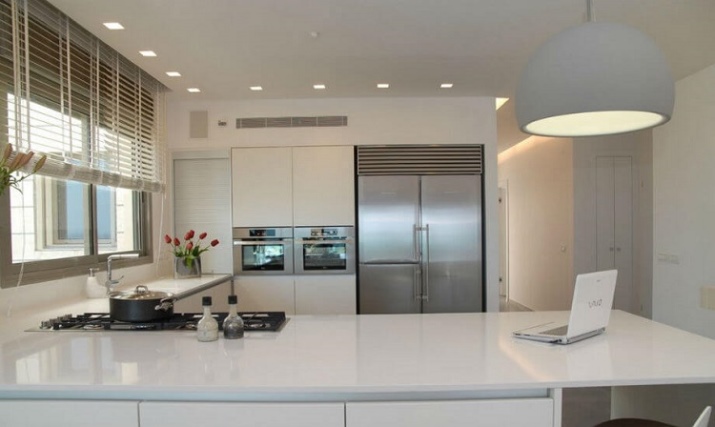


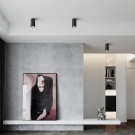
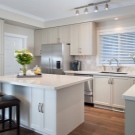
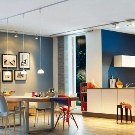
What it is?
Ceiling spots are local type lighting fixtures. Their main components are the base, the articulated arm and the luminaire. Lamps have movable holders, so they can be rotated in any direction. Spots are needed to direct light to a specific area of space. Point-type luminaires are used for uniform diffused lighting of premises. Models with additional equipment are able to change the degree of brightness.
These luminaires are used for area lighting when creating original lighting. They are installed on the ceiling of the kitchen, bedroom, living room, office. They are ideal for area lighting in open-plan apartments.
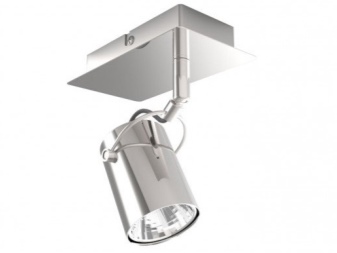
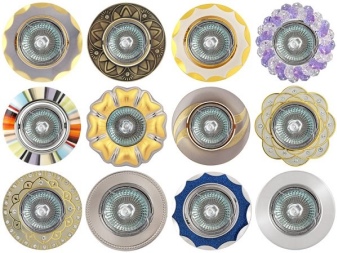
Description of species
By the type of installation, ceiling spots are built-in, overhead and combined. Products of the built-in type are mounted in suspended ceilings. Their body with wiring and bracket is hidden behind the ceiling sheet. Overhead models are attached to ceiling brackets. Their sizes are larger, the design is voluminous. Therefore, the mount does not fit behind the ceiling. They are mounted on special ceiling frames.
The fixing and design of the combined varieties are reminiscent of chandelier fixtures. They are suspended from the ceiling on a hook with the ability to change the direction of the light flux. All types of products can have not only single, but also group execution. Models on a bracket with 1 or more reflectors are characterized by a free change in the direction of light. Adjustable spots with mounting on a rod (rail) have designs with multiple luminaires. Depending on the design, they can be located in a straight or curved line.
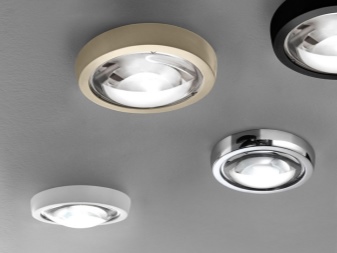
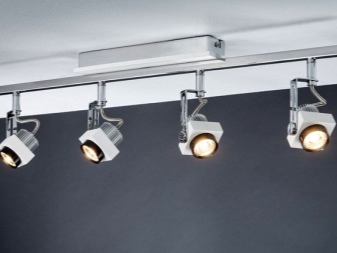
The individual variants have a flexible system of various configurations. Often, such models are installed for unusual illumination of niches. They can replace central lighting in small rooms. Products on tire systems move freely along the tensioned tire-ropes. In addition, they can rotate around their axis. This allows the light to be directed to a specific area.
By the type of light sources, the models are conventional, halogen, energy-saving, LED.
Models with incandescent lamps have no flicker effect. These light sources are inexpensive, but they heat up and damage the ceiling material.
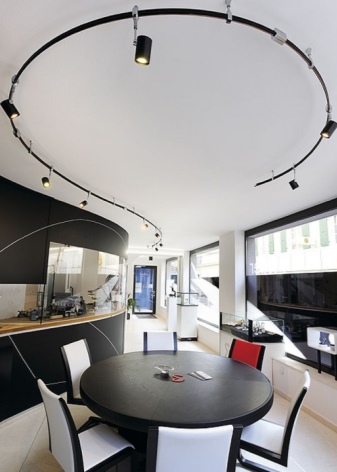
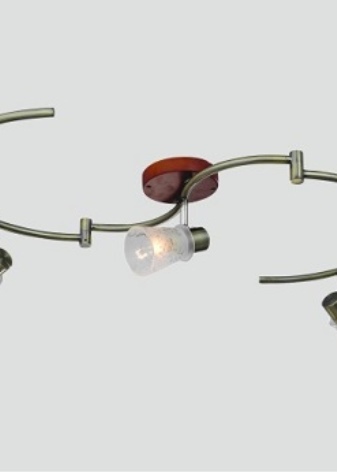
Products with halogen lamps are durable, but not very economical in terms of energy consumption. They come in low voltage and high voltage. They are harmless to humans, but they are more expensive than models with conventional bulbs.
Luminescent (energy-saving) light sources are used in hanging and overhead spots. They can have different temperatures of the light beam. In most cases, they have a large resource and high cost. LED bulbs are excellent at converting electrical energy into light. They have low heat dissipation. They are durable, compact and practical. Are expensive.
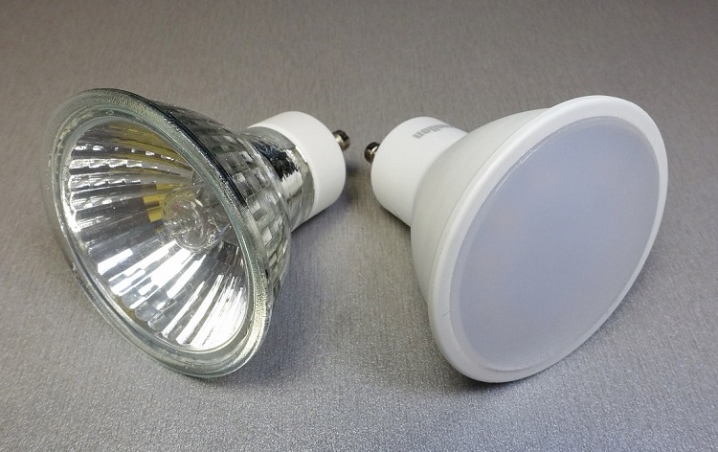
Design options
Design solutions for ceiling spots can be very diverse. On sale there are ordinary, magnetic, track models of various shapes. Lamps can be round, square, rectangular. In addition, there are volumetric modifications in the manufacturers' lines (spherical, domed, cylindrical). They can be large, small, on short, long rails. The shape of designer models can resemble bells, stars, cut diamonds.
The color palette of products is limited to metallic, neutral tones. The body of the spots can be white, black, silver, milky, brown. Less often it is performed with gold. Form and design determine the relevance of the model to a particular interior style. For example, ceiling spots for a loft-style apartment are deliberately rude.
Options for a classic room can be flat, star-shaped, ordinary rounded.
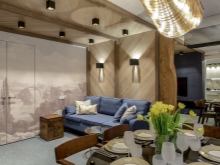
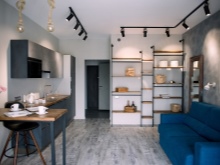
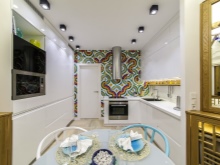
Products for lighting a minimalistic interior are simple geometric. Models for decorating TV areas in living rooms are often cylindrical. Their finishing can be the color of the case and its design. Collectible models can have unusual shapes. They can have glass shades (eg galvanized glass). Models of some of the author's works are made of expensive alloys and crystal.
Other options are made for wooden fittings. Some models do not include bulbs. This allows you to choose the light sources yourself at your own discretion. Models for lighting children's rooms can have thematic drawings on shared discs. For example, princesses, flowers, plant motives, birds. Shades can be transparent, matte, shiny. Original shades can even look like bees circling around a flower.
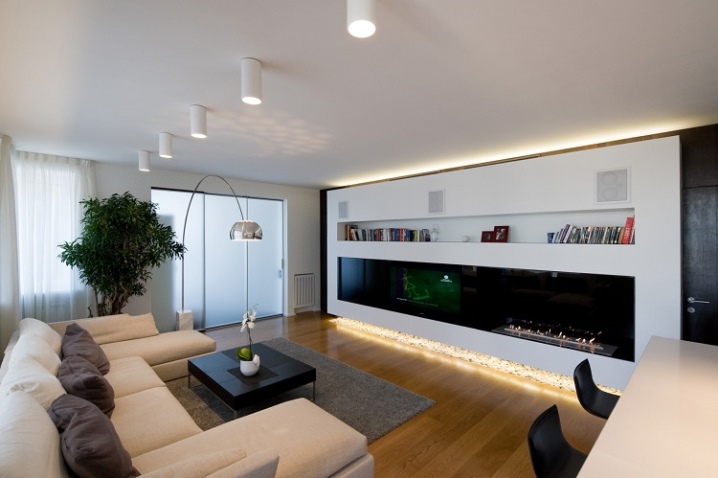
Criterias of choice
When choosing ceiling spots for lighting a bathroom, bedroom, hallway, nursery, living room, it is necessary to take into account a number of nuances. It is necessary to take into account the type of base and lamp, the type of ceiling structure. For example, any model is suitable for installing lighting fixtures in rigid ceiling systems.
However, for stretch ceilings, the GX53 options are preferable. These products are easier to install because they have a hole in the center of the socket for connecting a spot. In addition, it is possible to purchase models for the GU base of various standard sizes. However, they are not so easy to use.
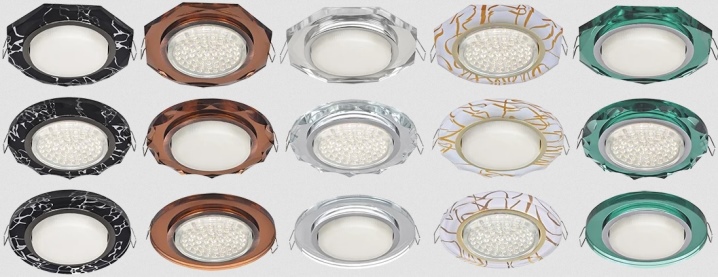
Power
The models differ in power consumption. The more it is, the more electricity the lamps consume. However, high power does not mean high brightness. You need to take an option with low power consumption and high luminous efficacy.
Much depends on the type of ceiling. For example, models with incandescent lamps cannot be purchased for tensioning structures. Even 60 watts is enough to ruin the film. Ideal accessories for drywall and stretch fabric are LED and fluorescent spots.

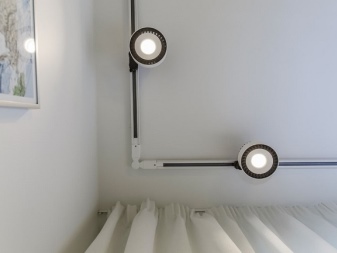
Swivel mechanism
The capabilities of the swivel mechanism differ from model to model. Built-in products do not have the same capabilities as overhead and combined models. They can illuminate any corner of the room, highlight certain objects.
In the case of repairs using a pivoting mechanism, the angle and side of the light beam can be changed. In this way, the configuration of the room can be adjusted. For example, you can illuminate the center of a room, arrange lighting around the perimeter.
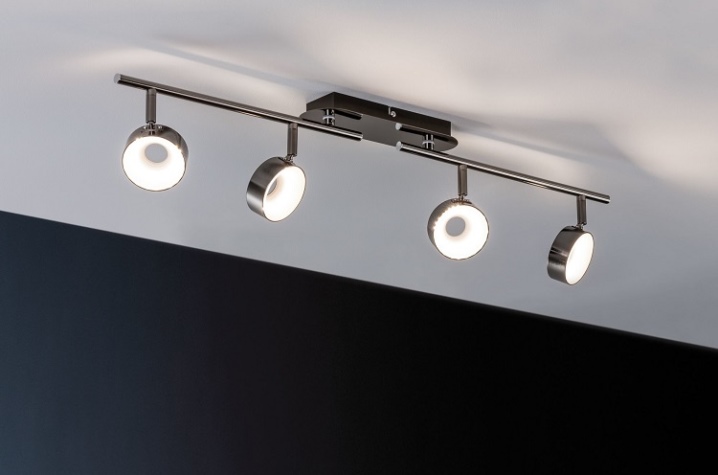
Dimensions (edit)
Built-in spots have the smallest parameters. They are used as auxiliary lighting and are often used to complement central ceiling lighting. In a spacious room, it is preferable to choose large group-type models. Artificial light should not harm your eyes. The length of the built-in models can be 8-10 cm.
The average spot weight (with a different number of lamps) can be 100-660 g.
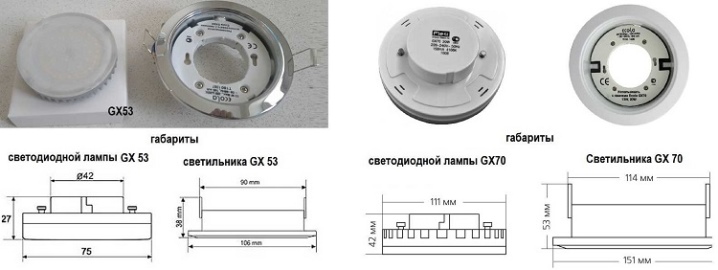
Location features
According to generally accepted rules, spotlights are placed at an equal pitch. The minimum distance between them is 20 cm. The standard distance to the edge of the wall is 20 cm.On average, 1 spot illuminates up to 1.5 m2. The location of the spotlight should not only be aesthetically pleasing, but also safe. In the bathroom, it is necessary to place the lamps away from wet areas. Such models must have a high protection class, increased moisture resistance.
In general, the layout depends on the availability, the number of other lamps in the same room. In a spacious room, they are placed around the perimeter. The installation scheme is coordinated with the central luminaire. In small rooms, there is often no need for chandeliers. If you choose a sufficient number of spots, they can replace the center light in full.
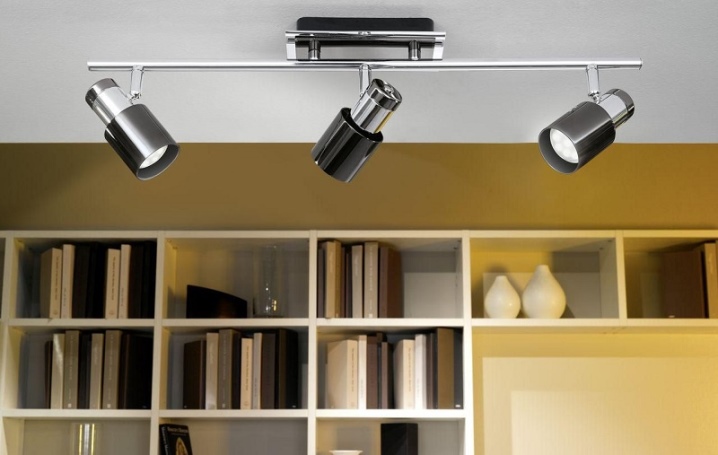
When choosing a certain light composition, the possibilities of illumination are taken into account. Most often this is the allocation of one or two functional areas. For example, you can designate a dining group, cooking area, seating area, recreation area, or home theater.
Spots can be placed in rows on opposite walls... Often they are mounted in the form of a geometric pattern: oval, rectangle, rhombus, square. When highlighting individual zones, they are built in the form of the letters S, C.

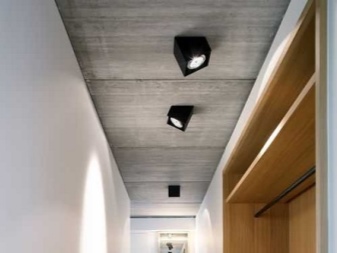
Style
Lighting devices should bear not only practical but also decorative load. The style of the spots is selected taking into account the style of the interior. If there are several products, their design must be the same. The type of construction is selected based on the purpose of the rooms. For bathrooms, they take built-in type models without frills. For bedrooms, living rooms, lamps with a variety of decorative shades are suitable.
These can be options in the form of many miniature spot-chandeliers with sparkling crystal pendants. Such products will decorate the interior of the living room, dining room, bedroom in a classic style. For modern rooms, you can choose laconic spots with a metal body.

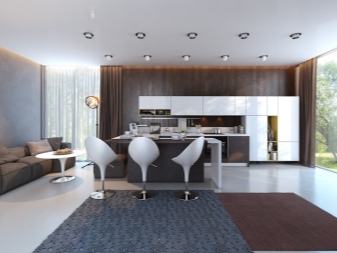
How to connect?
Device connection diagrams depend on the type of luminaires. The fixing of the soffit, depending on its type, can be an adjustable stand, hook, embedded suspended platform. The principle of fixing products has a common basis. The fixing system must be installed to the base plate prior to installing the ceiling. In this case, one should take into account its future level. This is especially true for suspended models.
Most often, spotlights are mounted on stretch and suspended ceilings. During the creation of the frame, wires are laid. They are fixed without being connected to the power supply. After that, they are engaged in the installation of suspensions, fixing lighting devices, connecting the cable. Fixing spots on drywall is easy. Installation is carried out after applying a putty layer. After creating a plan with a schematic arrangement of the luminaires, they are engaged in the wiring of electrical wires.
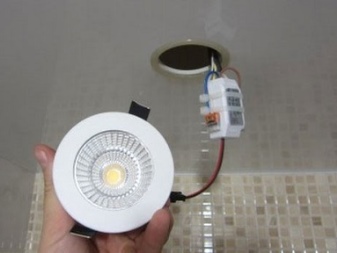
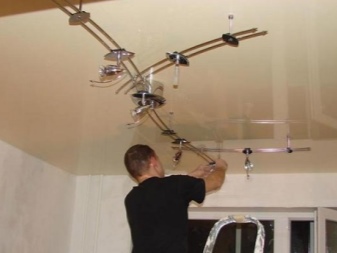
They are mounted on the ceiling so that the ends hang freely below the plasterboard sheet by 15-20 cm. Holes are cut in the ceiling to fit the spotlights. Next, you need to insert lamps into these holes, connect the wires, check the work of the spots. The hooks are fastened through the holes to the mounting platform. In the future, models of the combined type are suspended on them. Adjust the level of the platform so that its outline does not protrude beyond the vinyl sheet.
Overhead-type products are attached to the mounting platform over the film or drywall. Self-tapping screws are used as fasteners. If it is necessary to organize a multi-circuit lighting network, use a typical pair of two-core cables located in the ceiling to connect a chandelier with a two-button switch.
This point can be connected without a junction box.
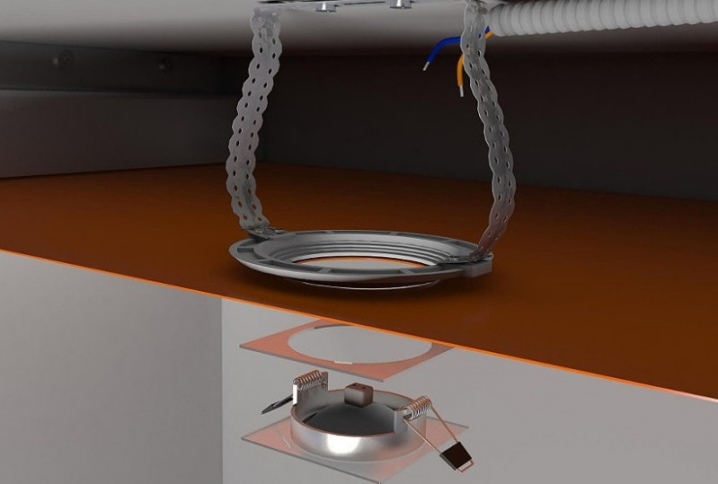
However, you cannot do without connecting terminals with paste. A common zero is found among the wires, the potential of the phase conductors is measured relative to the grounded structures. At the final stage of the work, fixtures are attached. When using standard racks with the ability to adjust, after fixing the center bracket, loosen the screw clamp.
Then the flanges of the luminaires are aligned in the ceiling plane. Next, tighten the clamps. In the course of working with homemade fasteners, a kind of accordion is created due to the bend in the folds. It holds its shape perfectly and can be adjusted with one hand.

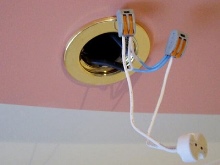

Examples in the interior
We offer several examples of a harmonious choice of ceiling spots in modern interior design:
- selection of lamps to illuminate the cooking area;
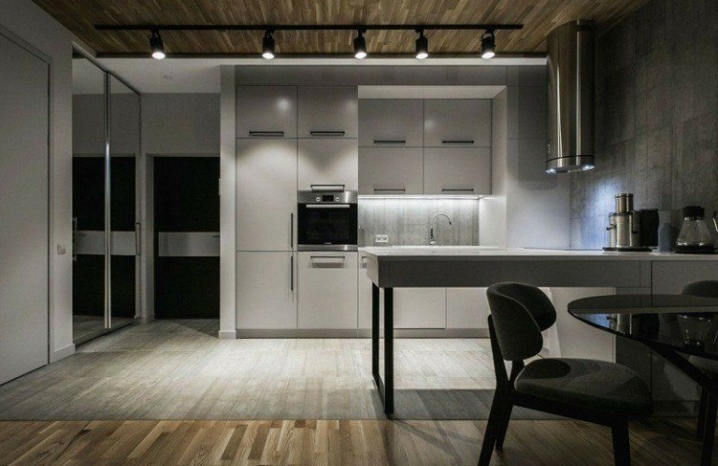
- design of hanging spots on the bar for the guest space;
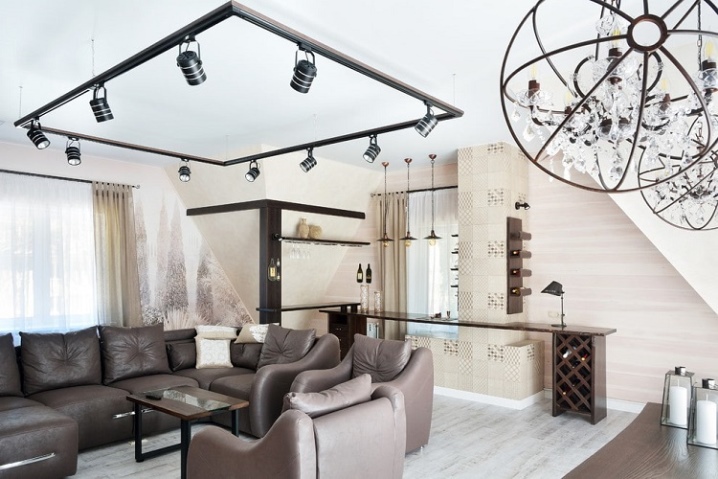
- spots with a swivel mechanism as an accent of a bright room;

- construction of several lamps with white shades;

- a spectacular version of the model for lighting a neutral interior;

- ring-shaped spots on a metal bar;
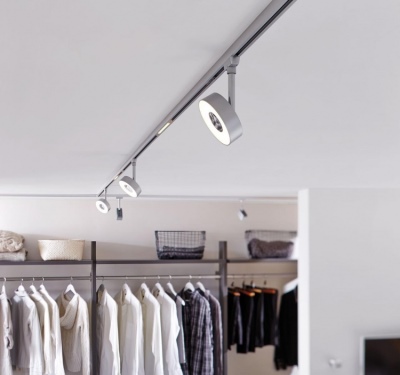
- arcuate structure of many lamps with adjustable angle of the light beam;
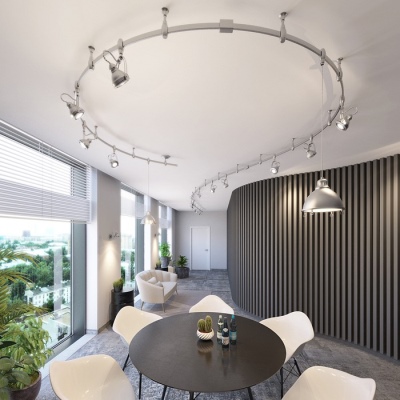
- zoning of space in a dwelling with combined rooms;
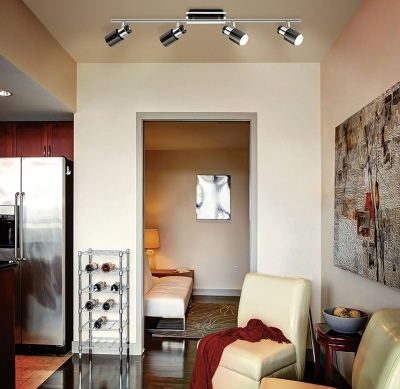
- the use of white spots for zonal lighting of the guest space;
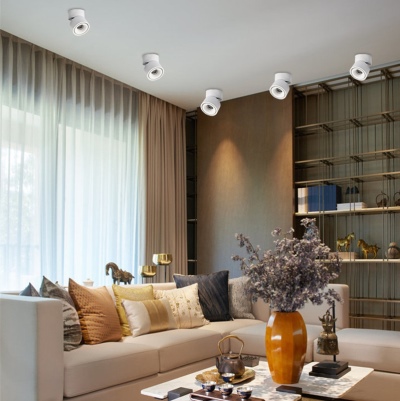
- pendant lamps to accentuate the sleeping area.
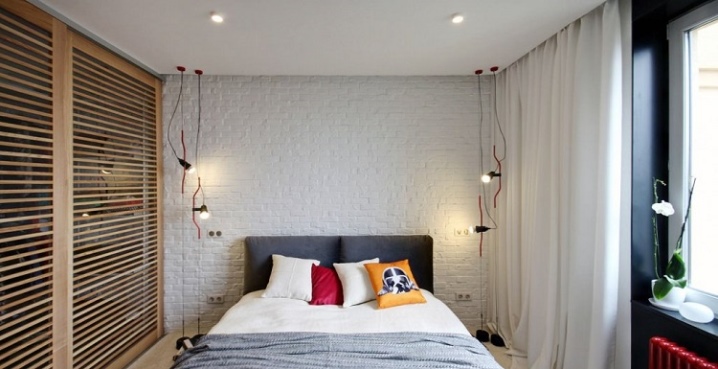












The comment was sent successfully.